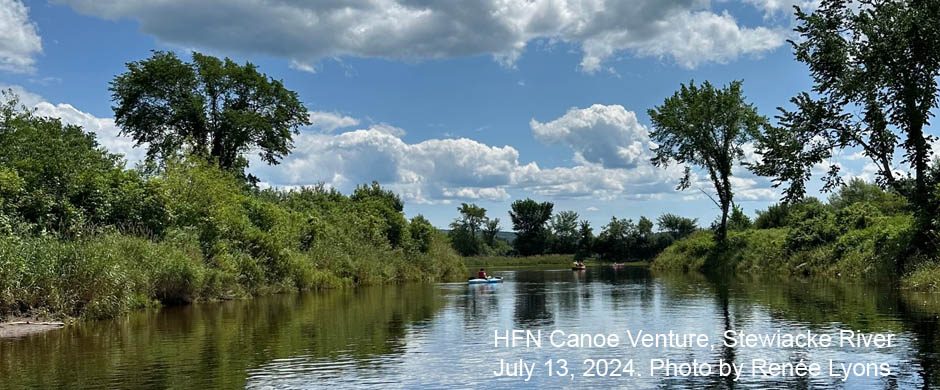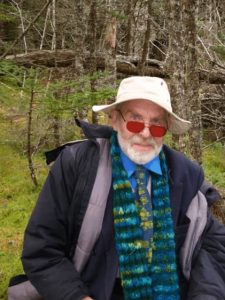This Colin Stewart Conservation Award for 2020 was to have been presented at the Halifax Field Naturalists Annual General Meeting on the first Thursday in March, 2020, at 7:30 p.m, at the Nova Scotia Museum of Natural History. COVID restrictions prevented that meeting, and the award was formally announced and presented at the 2020 AGM for the Halifax Field Naturalists held virtually (on Zoom) held on March 4, 2021.
The award is made posthumously to Wolfgang Maass (1929-2016) who pioneered lichen research and conservation in Nova Scotia.
From the nomination, by Nova Scotia Environment ecologist Robert Cameron:
The work of Dr. Maass led to the first lichen in Eastern Canada to be designated as endangered under the Species at Risk Act (SARA) and the first lichen to be listed in Nova Scotia under the provincial Endangered Species Act (ESA). Decades of work by Dr. Maass was the foundation which led to the listing of other lichen species both under the SARA and ESA. His pioneering work in lichen conservation began the initial efforts to protect these vulnerable species.
In the early 1980’s, Dr. Maass began searching and documenting locations, habitat, and populations of very rare lichens in Atlantic Canada. Dr. Maass published several scientific papers describing habitat and distribution of Boreal Felt Lichen and other rare lichens. These data and publications became the basis that allowed for the first listing for these species. The data that Dr. Maass collected is still being used today to assess more species.
Wolfgang Maass. Photo by Robert Cameron, taken in 2012 at the Ship Harbour Long Lake Protected Wilderness Area
His seminal paper on Boreal Felt Lichen entitled “Erioderma pedicellatum in North America: a case study of a rare and endangered lichen,” published in the Proceedings of the Nova Scotian Institute of Science, was one of the rst extensive studies of rare lichens and their conservation in northeastern North America, and laid the foundation for further status reports commissioned by the Committee on the Status of Endangered Wildlife in Canada. Other rare lichens he authored or co-authored papers on include Erioderma mollissimum, Hypogymnia (Cavernularia) hultenii, Pannaria lurida, and Moelleropsis nebulosa subsp. frullaniae, a new subspecies which he discovered in Nova Scotia and Newfoundland.
Dr. Maass, along with David Yetman, wrote the first report on Boreal Felt Lichen for the Committee on the Status of Endangered Wildlife in Canada (COSEWIC), which led to the designation of endangered status in NS and NB. Dr. Maass also co-authored the report on Vole Ears Lichen for COSEWIC, which led to its’ designation as endangered in Canada. Most importantly it was Dr. Maass’ decades of field work which enabled these species to be assessed.
He was also part of the first team to assess conservation status of lichens in Nova Scotia and his extensive knowledge of lichens in the province made a significant contribution to this process. Dr. Maass’ work continued well into his retirement. He was always willing to impart his extensive knowledge to others and always volunteered his time when asked to venture into the field.
Dr. Maass often did his work on a shoestring budget or with no funding at all, especially in his retirement. This work was done at a time when no one else was studying these rare species. He also studied the effects of air pollution on lichens and he made extensive collections that are now in the Nova Scotia Museum, New Brunswick Museum, and the Canadian Museum of Nature.
Not only did his work lead to endangered designations for Boreal Felt Lichen and Vole Ears Lichen, but also the data he collected over those many years on numerous rare and vulnerable lichens has allowed for their assessment and subsequent designations. These lichen species include Blue Felt Lichen (Nationally Special Concern, Provincially Vulnerable), Black Foam Lichen (Nationally and Provincially threatened), and Wrinkled Shield Lichen (Nationally and Provincially threatened).
Dr. Maass’ initial efforts on the COSEWIC report for Boreal Felt Lichen paved the way for the emerging and fledgling efforts at lichen conservation in NS and Canada.
Related
Obituary: Wolfgang Siegfried Gunther Maass 1929–2016
David H. S. Richardson & Robert Cameron, 2016. Symbiosis volume 69, pages 199–203. Full paper available here. Abstract: With the passing of Wolfgang Maass, Nova Scotia, Canada, and indeed the entire world of lichenology has lost an important pioneer in the documentation of the lichen flora of northeastern North America and a researcher dedicated to understanding the complex nature of lichen chemistry.
Forest lichens of Nova Scotia: creating access to baseline collections data
Stephen R. Clayden, 2017. Botany and Mycology Section, New Brunswick Museum, Final report to Nova Scotia Habitat Conservation Fund. “Project Goal: Contribute to the conservation of forest lichens and their habitats in Nova Scotia by organizing the extensive collections made by Wolfgang Maass between 1964 and 2004, digitizing their associated data, and making the collections and data readily available.”

